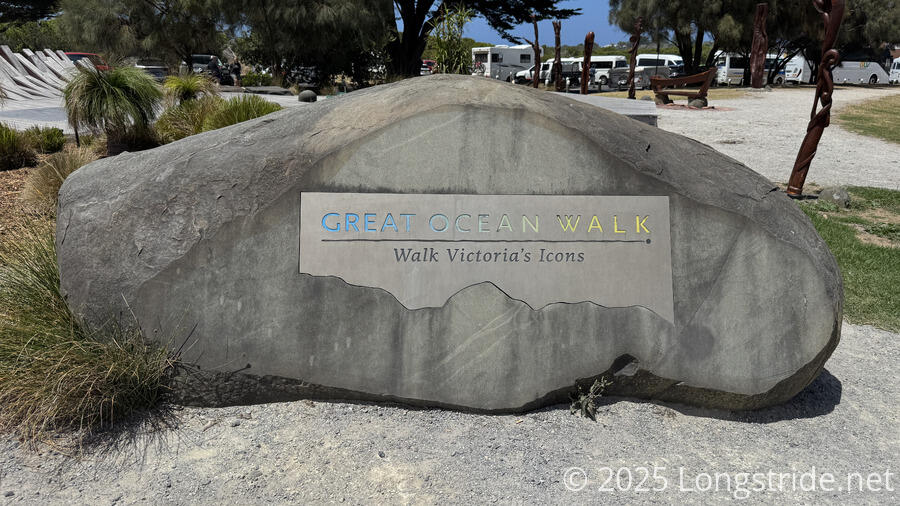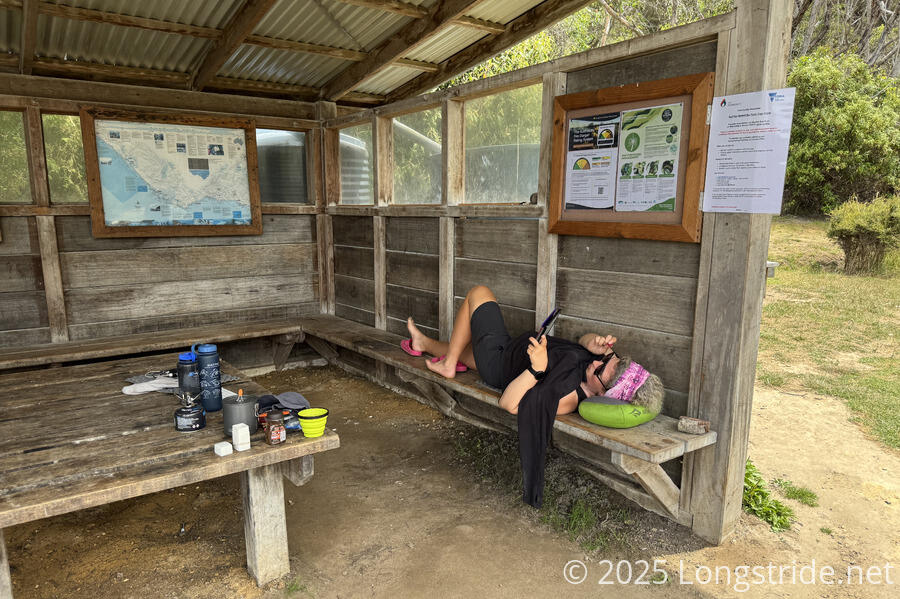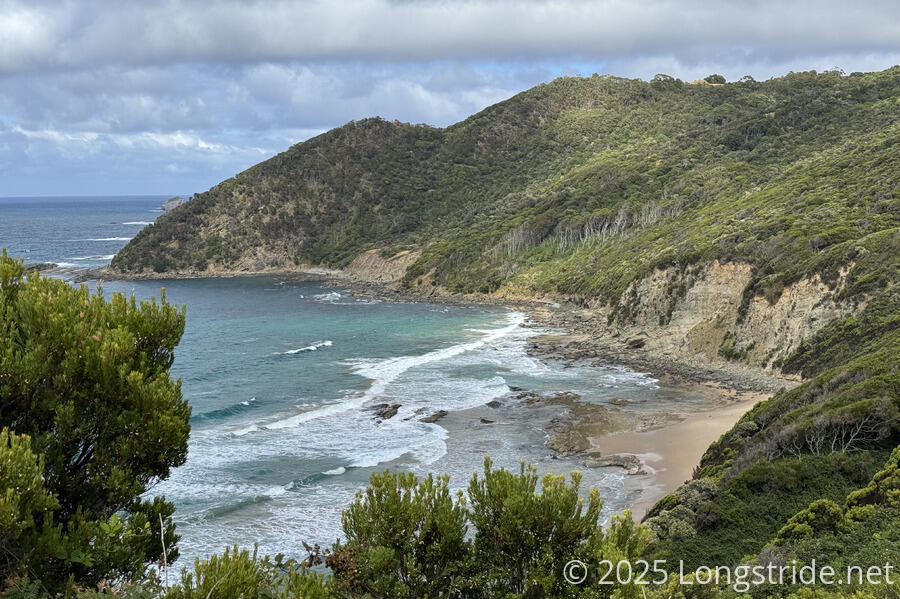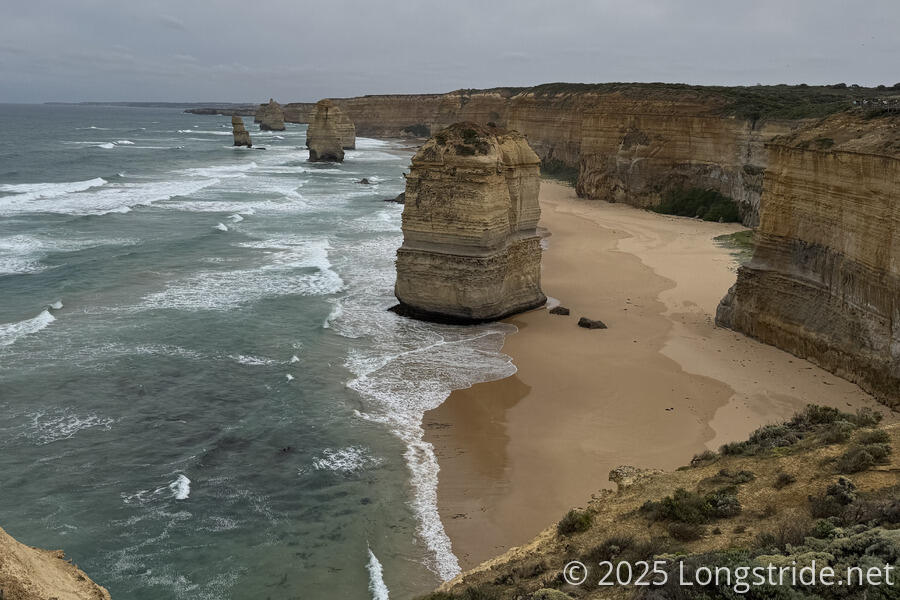In January, I hiked the Great Ocean Walk, a 97 km trail in south-eastern Australia. Running from Apollo Bay to the Twelve Apostles monument, and generally paralleling the Great Ocean Road, this trail is a somewhat easy tour of Australia’s rough and rugged “shipwreck coast”.
Having completed the Great South West Walk only days before I hiked the Great Ocean Walk, it’s hard to describe the GOW without comparison to the GSWW, and it’s hard to appreciate the GOW strictly on its own merits.
Like the GSWW, the GOW isn’t a difficult trail to hike. There are designated campsites at very reasonable intervals, each with a two-sided roofed shelter with maps and trail information, and generally plentiful water available from rainwater tanks. (Like the GSWW, campsites must all be reserved in advance, though the GOW is a much higher-demand trail, and we didn’t get our first pick of dates.) The trail is generally well-maintained, and easy to hike. There were only a couple of very steep sections, two of which included staircases. A couple of rivers required fording, but the rivers were not very deep, so this was not difficult.
Ironically, despite its name, the GOW spent a significant portion of time in forest, with no ocean in sight, and some of those forests were taller and denser than the “tall forests” section of the GSWW. (In fact, with the GOW being just over a third the length of the GSWW, the GSWW actually had more ocean-adjacent trail than the GOW!) But, with only a few exceptions, the GOW followed the cliffs above ocean (whether you could see it or not), and was usually less than half a kilometer from the water.
In contrast to the long, easily walkable beaches on the GSWW, the GOW’s beaches were on the much more rugged Shipwreck Coast. This kept the beach segments much shorter: it usually wasn’t very far until the cliffs jutted out towards the ocean, or the rocks from where the cliffs used to be piled up, making the beaches difficult or impossible to cross during high tide.
But this ruggedness put the ocean’s power on constant display. Whenever you could see the shore, you could often see several lines where the waves broke on rocks (or bedrock) just below the ocean’s surface. And if you missed that, several signs, monuments, and a cemetery showcased the many shipwrecks that once happened upon these shores.
In the forests, there was much less wildlife than the GSWW. Though we saw some koalas, wallabies, kangaroos, an echidna, and a few snakes, we saw many more of all of them on the GSWW, with a larger variety of other animals as well. The GOW’s forests were also nearly completely lacking the many bird and parrot species the GSWW’s forest had. This isn’t to say the GOW’s forests were bad, but, they certainly weren’t as loud or lively.
There were also a lot more people. While it was rare to see people on the GSWW, we saw other hikers every day on the GOW, especially at the campgrounds, some of which were filled to capacity. More people also meant more trash. While most of the trail was fine, near a few trailheads, the GOW had a surprising amount of garbage, mostly in the form of toilet paper.
The GOW’s terminus at the Twelve Apostles is definitely one of the more interesting trail termini of the many trails I’ve hiked. A set of limestone stacks, separated from the cliffs they once were joined to and in the process of gradually eroding away, demonstrate the incredible power of the waves and wind over time. (A tourist attraction in its own right, it was easily the most crowded trail terminus I’ve been at.)
Despite being closer to major population centers than the GSWW, the GOW is still somewhat remote, which made for challenging logistics. We didn’t have much trouble getting to the start of the GOW with public transportation, but its terminus is essentially in the middle of nowhere and has fewer public transportation options than the GSWW. The GSWW’s loop nature made it as easy to leave as it was to arrive, but for the GOW, our timing was off, and we finished the trail on a day when there were no public transit options. (We got a lucky ride back to Melbourne with another hiker who finished shortly after we did and who also lived there, but had that not happened, we’d have had to try and hitchhike, if not to Melbourne, then to a closer city on a train line.)
I think I would have liked the GOW much more if I hadn’t already been “spoiled” by the GSWW. That said, I still enjoyed the Great Ocean Walk. At just under 100 km, it’s an easy eight-day hike. There are seven designated campsites, which gives a 12 km/day average if you stop at every one. This, plus the incredible ocean scenery make the Great Ocean Walk an easy recommendation.



